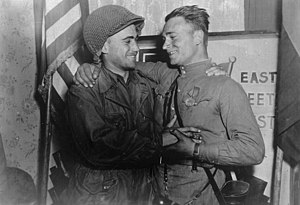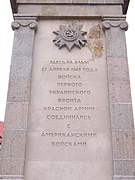
The Battle of Berlin, designated as the Berlin Strategic Offensive Operation by the Soviet Union, and also known as the Fall of Berlin, was one of the last major offensives of the European theatre of World War II.

Torgau is a town on the banks of the Elbe in northwestern Saxony, Germany. It is the capital of the district Nordsachsen.

The 69th Infantry Division, nicknamed the "fighting 69th," was a Division of the United States Army formed during World War II. It is distinct from the 69th Infantry Regiment.
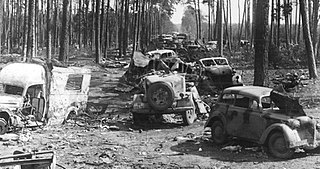
The Battle of Halbe was a battle lasting from April 24 – May 1, 1945 in which the German Ninth Army—under the command of General Theodor Busse—was destroyed as a fighting force by the Red Army during the Battle of Berlin.

Strehla is a small town in the district of Meißen, Saxony, Germany. It is located on the river Elbe, north of Riesa. This place name means arrow in Sorbian. Strehla includes the following subdivisions:

The 1st Belorussian Front was a major formation of the Soviet Army during World War II, being equivalent to a Western army group. The 1st Belorussian Front along with the 1st Ukrainian Front were the largest and most powerful among all Soviet fronts, as their main effort was to advance on the Nazi German capital Berlin.

The 3rd Guards Army was a field army of the Soviet Red Army that fought on the Eastern Front in World War II.

The Battle of the Oder–Neisse is the German name for the initial (operational) phase of one of the last two strategic offensives conducted by the Red Army in the Campaign in Central Europe during World War II. Its initial breakthrough phase was fought over four days, from 16 April until 19 April 1945, within the larger context of the Battle of Berlin. The Soviet military planners divide the frontal and pincer phases of the operation, named Berlin Strategic Offensive Operation into:

The 13th Guards Poltava Order of Lenin Twice Red Banner Orders of Suvorov and Kutuzov Rifle Division was an infantry division of the Red Army that was highly decorated during World War II.

The Line of Contact marked the farthest advance of American, British, French, and Soviet armies into German controlled territory at the end of World War II in Europe. In general a "line of contact" refers to the demarcation between two or more given armies, whether they are allied or belligerent.

Zeithain is a municipality in the district of Meißen, in Saxony, Germany.

The 40th Army of the Soviet Ground Forces was an army-level command that participated in World War II from 1941 to 1945 and was reformed specifically for the Soviet–Afghan War from 1979 to circa 1990. The Army became the land forces arm of the Soviet occupational force in Afghanistan in the 1980s, the Limited Contingent of Soviet Forces in Afghanistan.
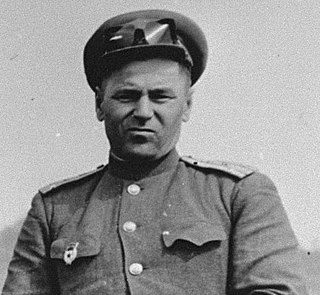
Vladimir Vasilyevich Rusakov was a Soviet Army major general.

Encounter at the Elbe is a Soviet war film released in 1949 from Mosfilm, describing the conflict, spying, and collaboration between the Soviet Army advancing from the east and the U.S. Army advancing from the west. The two allied forces met each other for the first time on the River Elbe near the end of the World War II. This meeting occurred on April 25, 1945, which was usually remembered as “Elbe Day” in Western Bloc nations and as the "Encounter at the Elbe” in Eastern Bloc nations.

Joseph Polowsky (1916–1983) was an American soldier who with others met Soviet troops on the banks of Elbe River on April 25, 1945, and later became an anti-war activist.

The 5th Guards Army was a Soviet Guards formation which fought in many critical actions during World War II under the command of General Aleksey Semenovich Zhadov. The 5th Guards Army was formed in spring 1943 from the 66th Army in recognition of that army's actions during the Battle of Stalingrad. The 5th Guards Army fought in the Battle of Kursk, Belgorod-Khar'kov Offensive Operation, Battle of the Dnieper, Uman–Botoșani Offensive, Lvov–Sandomierz Offensive, Vistula–Oder Offensive, Berlin Offensive, and the Prague Offensive. During the Berlin Offensive elements of the army linked up with American troops at Torgau on the Elbe. Postwar, the army was disbanded as part of the Central Group of Forces.

The 4th Guards Tank Army was an operational military unit within the Armed Forces of the Soviet Union during the Great Patriotic War and in the post–war period.
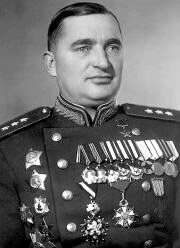
Aleksey Semenovich Zhadov, born with the surname "Zhidov", was a Soviet military officer in the Red Army, who during World War II commanded the 66th Army, later renamed the 5th Guards Army, from the Battle of Stalingrad up till the end of the war. For his leadership of the army, Zhadov was awarded the title Hero of the Soviet Union. Postwar, Zhadov commanded the Central Group of Forces and was deputy commander of the Soviet Ground Forces.
The 58th Guards Rifle Division was an elite Guards infantry division of the Red Army during World War II.

Jürgen Möller is a German former officer, and a military historian, focused on the exploration of the end of World War II in Germany in 1944/45, especially the American occupation of Central Germany.
